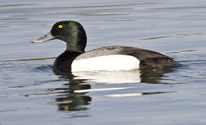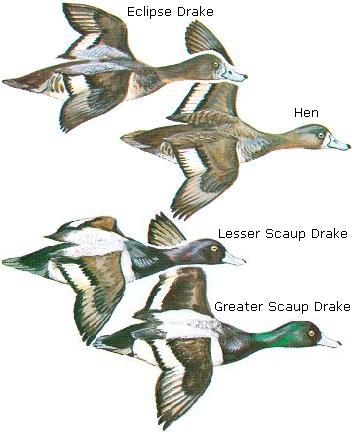Wildlife - Species

Species Specific Regulations
Greater Scaup
Licenses: Hunting License required. Migratory Bird Hunting and Conservation Stamp (Federal Duck Stamp) that is validated by the hunter signing the stamp in ink across the face of the stamp
Limits: Please see Migratory Bird Regulations for any game zones restrictions or Limitations.
Greater Scaup (Aythya marila)

Description
Greater and lesser scaups appear nearly identical in the field but they have some subtle differences. Greater scaups have a light band near the trailing edges of the wings runs almost to the tip, but in lesser scaups it runs only about half way. The greater scaup is also slightly larger and has a flatter top of the head.
Average Size
Greater scaups have an average length of 18 ½ inches and an average weight of 2 pounds. Lesser Scaups have an average length of 17 inches and an average weight of 1 7/8 pounds.
Range
The greater scaup can be found in all 4 flyways but are most common in the coastal flyways. They are found along the coast of South Carolina in winter only.
Preferred Habitat
Throughout the year these scaup prefer still water like those found in lakes, ponds, bays and inlets. In the winter months they are found almost exclusively in marine habitats like shallow, saltwater bays and brackish river inlets.
Typical Flock Pattern

Wings

Food Habits
Greater scaup have a varied diet, fluctuating based on season and availability. The main food items are small bivalves, snails, crustaceans, aquatic insects, seeds, and the vegetative parts of aquatic plants.
Reproduction
Pairs are formed on the wintering grounds, just before spring migration. The female constructs the nest in dense grass near water. After scraping out a depression and lining it with grass the hen lays 5-13 brownish olive buff eggs.
Sound
Drake has a discordant scaup, scaup, and hens are silent.
Behavior
- Migrate late, sometimes just before freezeup.
- Flock movements are rapid, often erratic, usually in compact groups.
- Males are not territorial but will actively defend mates.
- Can be found in large flocks, especially in the winter.
- Rarely flocks with other species, when flocking with lesser scaups, will remain grouped with members of their own species.
Citations, Publications and Literature
U.S. Fish & Wildlife Service, Federal Duck Stamp Office Presents: North American Waterfowl (Adobe PDF file)
Kessel, Brina, Deborah A. Rocque and John S. Barclay. 2002. Greater Scaup (Aythya marila), The Birds of North America Online (A. Poole, Ed.). Ithaca: Cornell Lab of Ornithology; Retrieved from the Birds of North America Online
South Carolina waterfowl hunters 16 and older are required by state law to obtain a state migratory waterfowl permit and Migratory Game Bird permit. Both permits must be in the hunter's possession while hunting or transporting legal waterfowl. A state waterfowl permit is included with the Lifetime Senior, Lifetime Gratis and Disability Licenses. S.C. residents who hold a Lifetime Senior or Lifetime Gratis License are not required to have a Migratory Game Bird permit.
National Migratory Bird Harvest Information Program (HIP)
The waterfowl permits and HIP permits are available from select DNR offices and from hunting and fishing license agents.
